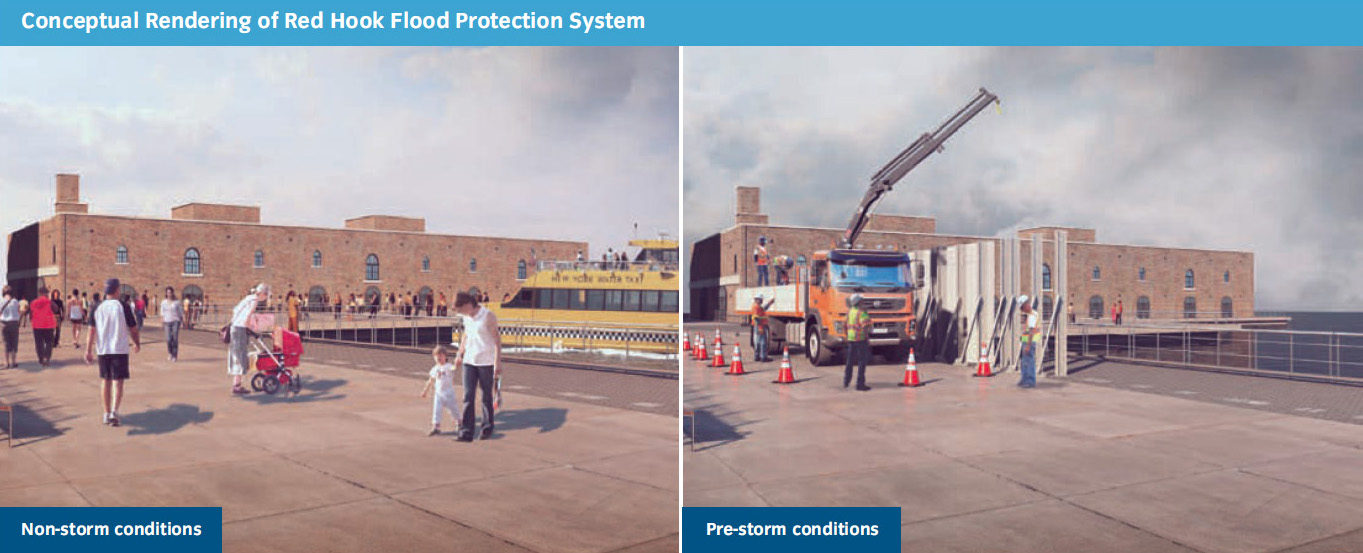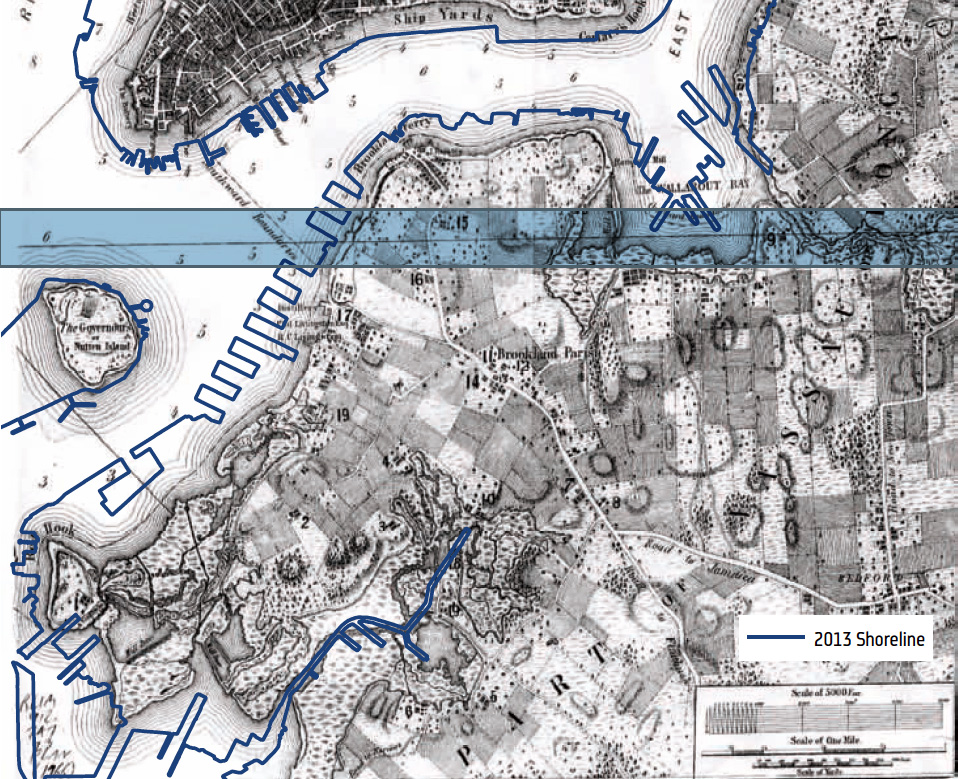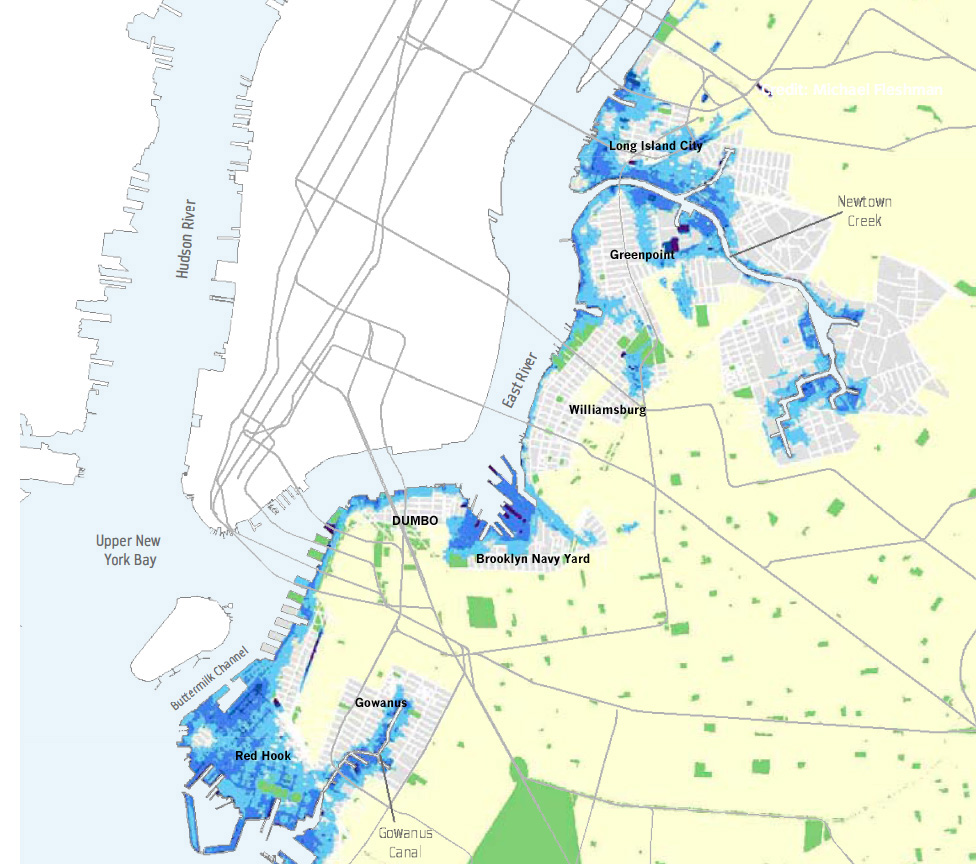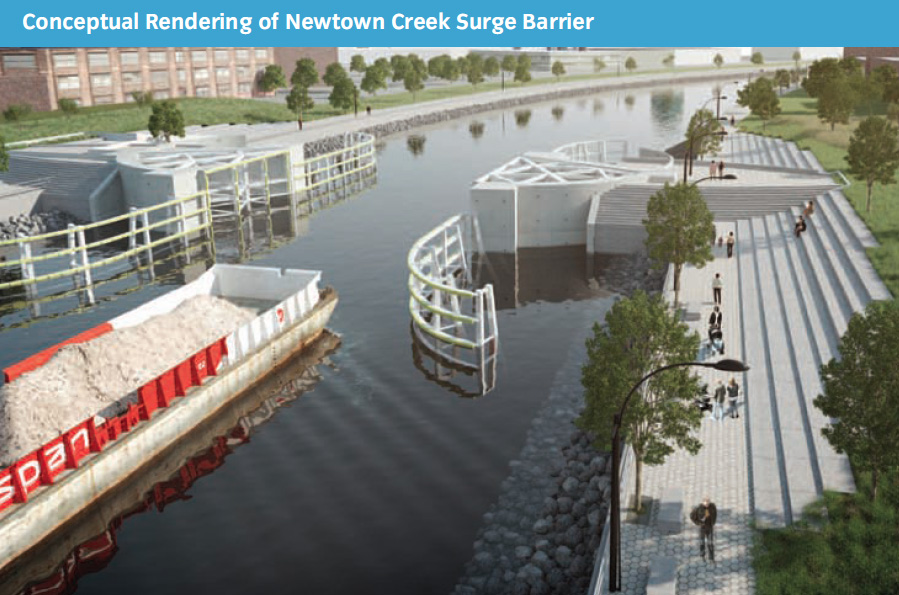
On June 11, 2013, the City released the Special Initiative for Rebuilding and Resiliency report (SIRR), containing a comprehensive analysis of Hurricane Sandy, as well as analyzing future risks to the five boroughs brought on by climate change and sea level rise.
The full report (online or in print) is a lucidly written but daunting 438 pages. In advance of the one-year anniversary of Sandy, City Atlas will be running summaries through coming weeks. We’ve boiled the 438 page original down to 60 pages, with an emphasis on the five community chapters, which show in practice how the initiatives in the SIRR would reshape the city towards greater resilience.
In sum, the SIRR is a thirty year plan for a coastal city of eight million people; at present it is likely the most detailed climate change adaptation plan anywhere.
In parallel with our consideration of the SIRR, we plan also to track a project developed at the Architectural League titled “The Five Thousand Pound Life” — which promises a deeper study of lifestyle, climate change, and energy use, in recognition of the fact that adaptation alone will only get the city so far.
____

The Brooklyn-Queens Waterfront is a coastal area along the East River’s eastern bank. Home to nearly 100,000 residents and 8,600 businesses, the Waterfront comprises nine areas with varying geographic and demographic landscapes: Sunset Park, Red Hook, Gowanus (along with the Gowanus Canal), DUMBO, Brooklyn Navy Yard (major industrial facility and its adjacent residences), Williamsburg, Greenpoint, Newtown Creek (an industrial waterway), and Long Island City.
The Waterfront’s principal vulnerability is coastal flooding, the risk of which has in recent years been exacerbated by sea levels that a powerful storm surge can render disastrous. Sandy made this reality exceptionally apparent: storm surge flooding from the East River, the harbor, Gowanus Canal, and Newtown Creek affected some 3,100 businesses and nearly all Waterfront residents. Waterfront residences and businesses faced inundation, loss of power, and combined sewage overflow that backed up sewage, and residents were significantly affected by flooding in the area’s major roads and tunnels. Greenpoint businesses, the Red Hook Houses (NYCHA), the Brooklyn Navy Yard, and the R-train tunnel are among some of the hardest hit areas in Waterfront and are mentioned explicitly as such in the SIRR report.
The industrial sector dominates the Waterfront economy: 3300 industrial companies occupy 40% of total built square footage and 40% of all businesses in the Waterfront. City wastewater management, food and equipment manufacturers, and civil engineering firms comprise the area’s largest employers, but they also serve vital functions to the city’s remaining boroughs. As such, restoring the Waterfront’s industrial sector is vital to its full economic revitalization, as well as to restoring a mainstay of the community.
Red Hook receives a lot of individualized attention in this chapter of the SIRR. Here are a few reasons why:
-
It’s home to the largest public housing development in Brooklyn, the Red Hook Houses, which was significantly damaged during the storm is still has yet to be fully restored
-
All yellow- and red-tagged buildings on the Waterfront (the tags signify extent of damage) were clustered in either Red Hook or Greenpoint
-
The neighborhood is isolated and marginalized by transportation—no subway routes run through Red Hook and bus routes are limited
-
A significant portion of the 100-year floodplain expansion lies in Red Hook
-
Most 1-to-3-family homes in Red Hook were built in the 19th-century as attached, therefore elevation as a flood mitigation strategy is not feasible. This forces the city to develop different flood protection strategies than it otherwise would have.
The initiatives set out by the city can be roughly broken down into four categories, with Insurance, Health Care Initiatives, Parks, and Water and Watershed as separate areas of interest. The four main categories are: Coastal Protection, Buildings, Critical Infrastructure, and Community and Economic Recovery. The City will implement a combination of city-wide and Brooklyn-Queens Waterfront (BQW)**-specific initiatives (of which there at 11) to rebuild and strengthen the Waterfront for posterity. The report mentions Food Supply, Solid Waste, and Environmental Protection and Remediation, but does not cite any specific initiatives for the Waterfront.

Here are brief summaries for each category. Below them you’ll find paraphrases of each section of the chapter.
|
Coastal Protection – Buffer against flooding and storm surge Buildings- Regulate and retrofit Critical Infrastructure (under which I grouped Utilities, Liquid Fuels, and Transportation) – Harden and diversify Insurance- Incentivize, make more affordable, and shape to fit needs of Waterfront residents Healthcare – Rebuild and retrofit facilities; improve communication between patients and providers; increase storm resiliency Parks – Fortify as line of defense Water and Wastewater – Strengthen wastewater management facilities; improve sewer system Community and Economic Recovery – Prepare and educate families and individuals; revitalize commerce; create attractive open spaces |
Coastal protection – buffer against flooding and storm surge
Coastal protection for the Waterfront largely means addressing storm surge flooding damage and mitigating future flood risk that only worsens as sea levels rise.
These initiatives seek to:
-
Increase coastal edge elevations with bulkheads city-wide and specifically in Newtown Creek (Coastal Protection Initiative 6; BQW Initiative 4)
-
Minimize upland wave zones by exploring in-water and coastal protection measures in Southwest Brooklyn, DUMBO, and Brooklyn Bridge Park (BQW Initiatives 1 and 3). These include in-water protection measures including the creation of oyster habitats and wetlands.
-
Protect against storm surge with barriers and floodwalls at Newtown Creek (Coastal Protection Intitiative 26), ConEdison’s Farragut substation (Coastal Protection Initiative 25) , and the Gowanus Canal (BQW Initiative 2)
-
Improve coastal design and governance, which is especially important to Williamsburg, Greenpoint, and Long Island City, areas in which the 100-year floodplain has expanded most. These areas are economically important to the Waterfront in that they have become and are slated for “significant new development” in the coming decade. As such, the City is in the midst of developing flood protection strategies for these areas (BQW Initiative 5). Red Hook will also see a completed design for a new integrated flood protection system by 2016 (Coastal Protection Initiative 23).
A number of these plans will enlist the aid and cooperation of the USACE and Con Edison, and will take action on the part of private and public organizations. Coastal protection of the Waterfront are measures City Hall envisions commencing this year, with certain studies and infrastructural projects ending by 2015 and 2016.

Buildings – regulate and retrofit
The City’s plans for building in the future is oriented around creating and adopting new resiliency standards through policy and retrofits. The report targets homeowners, residents living in substantially damaged units, the industrial buildings that line the Waterfront, and city-wide building regulations. Across the board, the report beckons all residential and business property owners to retrofit.
-
Residents and homeowners
-
Incorporating new resiliency standards, the report includes an initiative to restore and rebuild private residential properties substantially damaged in the storm (Buildings Initiative 2). The same also initiative offers residents financial assistance to residents and assistance in assessing the scope of repair.
-
Public housing: The City also pledges to repair and retrofit 3000 public housing units in 28 buildings along the Waterfront, many of which bore the brunt of Sandy and have not fully bounced back. It is currently assessing 36 additional buildings for resiliency improvements (Buildings Initiative 9).
-
Design and rebuild: The City hopes to erect neighborhood-specific Community Design Centers to assist property owners in developing design solutions (Buildings Initiative 8).
-
Encouraging retrofits: The City will launch a city-wide $1.2 billion program to incentivize retrofits and the adoption of new resiliency standards in buildings that lie within the 100-year floodplain. 1-to-3-family homes will see $100 million of this money, and affordable housing will also see $100 million (Buildings Initiative 7).
-
Home buyouts: Lastly, the City will adopt the state’s Smart Home Buyout Program to identify homes eligible homes (Buildings Initiative 5). Interestingly enough, no homes along the Waterfront have been identified as eligible.
-
-
Industrial buildings are extremely vital to the economy and culture of the Waterfront and extremely vulnerable to storms. The City will launch a $10 million incentive program to encourage owners of industrial buildings to make resiliency investments (Buildings Initiative 10). The City will also follow through with planned upgrades, such as elevation of electrical systems or installation of waterproof doors, to City-owned industrial properties including Bush Terminal, Brooklyn Navy Yard, Brooklyn Army Terminal, Brooklyn Cruise Terminal, and South Brooklyn Marine Terminal (Brooklyn-Queens Waterfront Initiative 6).
-
For building regulations, the report also proposes a number improvements and amendments to current building codes and regulations that factor in resiliency measures as well as the risks of building on the 100-year floodplain (Buildings Initiatives 1, 3, 6, 12, and 13). The city encourages buildings with the 100-year floodplain to adopt new codes and retrofit through mandates and monetary incentives (Building Initiatives 7).
Critical infrastructure – harden and diversify
Utilities – Initiative 5, 6, 7, 21
There are no Waterfront-specific utilities initiatives. All in all, the City will incorporate risk-based analysis in utility regulation and investment decision-making; will call for capital investments to make energy infrastructure more flexible in responding to disruptions; and will work to better diversify the city’s sources of energy.
Liquid Fuels – Initiatives 1, 4, 5, 8, 9
Again, there are no Waterfront-specific initiatives for liquid fuels. Overall, the City wants to be more involved in the regional liquid fuel supply chains, which are couched in federal and state jurisdiction complexities. The City will therefore call on federal government to convene a regional working group to develop a strategy to strengthen fuel infrastructure; and work with the state to develop incentive program for gas stations to get generators.
Transportation – Initiatives 1, 3, 5, 6, 8, 9, 10, 16, 17, BQW Initiatives 7-9
The City will: make the system more flexible and more resilient; protect critical elements of the system from damage; seek to maintain system operations during extreme weather events and, following extreme events, to enable quick recovery, while also putting in place plans for backup transportation options until regular service can be restored; reconstruct key streets, elevate traffic signals and provide backup power.
BQW-specific transportation initiatives
-
In addition to the preexisting structural vulnerabilities of buildings, Red Hook also is at geographic disadvantage from a transportation perspective. Subway lines don’t run through Red Hook and bus routes don’t adequately connect the neighborhood to the rest of Brooklyn and to Manhattan. In this sense, Red Hook is isolated. NYCDOT has put forth an effort to make public transportation more accessible to Red Hook residents with new bus lines. The City has provided free ferry service between Red Hook and Manhattan that will cease after Labor Day 2013.
Healthcare – Initiatives 2-12
Rebuild and retrofit facilities; improve communication between patients and providers; increase storm resiliency
Here’s the jist of it. No Waterfront-specific initiatives:
-
Build new hospitals, nursing homes, and adult care facilities to higher resiliency standards and harden existing facilities to protect critical systems;
-
seek to keep lines of communication open between patients and providers, even during extreme weather events;
-
and enable community-based providers to reopen quickly after a disaster.
Telecommunications – Initiatives 1, 2
-
Creation of DoITT (Department of Information Technology and Telecommunications)
-
new resiliency requirements mandated by city
Insurance – Initiatives 1, 4, 6
Incentivize, make more affordable, and shape to fit needs of Waterfront residents –
At the time Sandy hit, only 50% of homeowners in New York had flood insurance. The majority of Waterfront residences are older, attached row homes built in the 19th century. This makes home elevation pretty much impossible as a risk mitigation strategy for Waterfront residents. Therefore,
-
the City proposes to work with FEMA on determining other mitigation strategies.
-
the City will also work with FEMA and the NFIP (National Flood Insurance Program) to assess/adjust flood insurance affordability. The City will encourage NFIP to increase deductibles in order to decrease premiums. This will give incentive to those who don’t see the need for flood insurance to purchase it.
Parks – Initiatives 2, 11 – Fortify as line of defense
-
Parks can serve as effective buffers against flooding. The City wants to take further advantage of this green fortification by hardening and modifying shoreline parks including Bush Terminal Piers Park, Bushwick Inlet Park, Brooklyn Bridge Park, Box Street Park, and the Red Hook Recreational Area. DPR will complete a study of these areas in 2014.
-
Improving health and resiliency of the city’s urban forests is another priority. The report doesn’t identify any specific Waterfront forests.
Water and Wastewater – Initiatives 1, 2, 3, 8, 9 – Strengthen wastewater management facilities; improve sewer system
These target CSOs and wastewater treatment:
-
CSO (combined sewer overflow) is likely an acronym you encountered in your reading. It’s the discharge from a CSS (combined sewer system—which collects stormwater runoff, domestic sewage, and industrial wastewater in the same pipe) that is precipitated by flooding. Since storm surge flooding was the Waterfront’s biggest problem, these neighborhoods suffered CSOs which pose as significant environmental and health hazards. Furthermore, the Gowanus Canal and Newtown Creek have been designated as Superfund sites by the EPA—sites requiring long-term response to clean up hazardous material contaminations. In short, flooding is very bad. Surprisingly, there’s nothing in here on mold remediation which has been a huge problem to Sandy-affected communities across the board.
-
The City is considering reducing CSOs with high-level storm sewers, which would sit on top of CSS pipes and capture up to 50% of rainfall because it enters CSS. This won’t happen for another decade.
-
The City also wants to develop CSO long-term control plans (LTCPs) for Gowanus Canal (by 2015) and Newtown Creek (by 2017).
-
-
Wastewater treatment: The City wants to “harden” wastewater facilities, treatment plants, and water pumping stations and equip them to withstand future flooding. These will be implemented in 2014
Community and Economic Recovery – Prepare and educate families and individuals; revitalize commerce; create attractive open spaces
Community Disaster Preparedness – Initiatives 1, 2
-
During these times (when contributions from these networks and sectors are desperately needed) these organizations and businesses themselves are frequently coping with the same set of challenges that the community at large is–a circumstance that can push even the most well-run organization or business to the breaking point
-
identify and address gaps in community capacity – carried out by OEM and CEO – begin in 2013
-
support CERTs – launched by 2014
Economic Recovery – Initiatives 1-6
Though industrial business predominates over Waterfront communities, the economic recovery initiatives highlighted for the Waterfront seem to prioritize local commerce. Through retail recovery programs, financial and technical support from SBS (Small Business Services), and financial incentives, the City encourages local businesses to improve commercial corridors and identifies eight by street name that will receive this support.
Finally, BQW Initiatives 10, 11
The Brooklyn Queens Waterfront specific initiatives don’t target small businesses and local merchants; instead, they aim to invigorate residential and industrial areas that have the potential for commercial development. The Red Hook Houses is one such area that will receive capital improvements to attract new retailers and create new jobs (BQW Initiative 10). The Brooklyn Navy Yard is another such space pinned for redevelopment and the creation of Admirals Row, Building 77, the Green Manufacturing Center, and the expansion of Steiner Studios (BQW Initiative 11). The City is also looking at building and expanding five new waterfront parks (BQW Initiative 11).